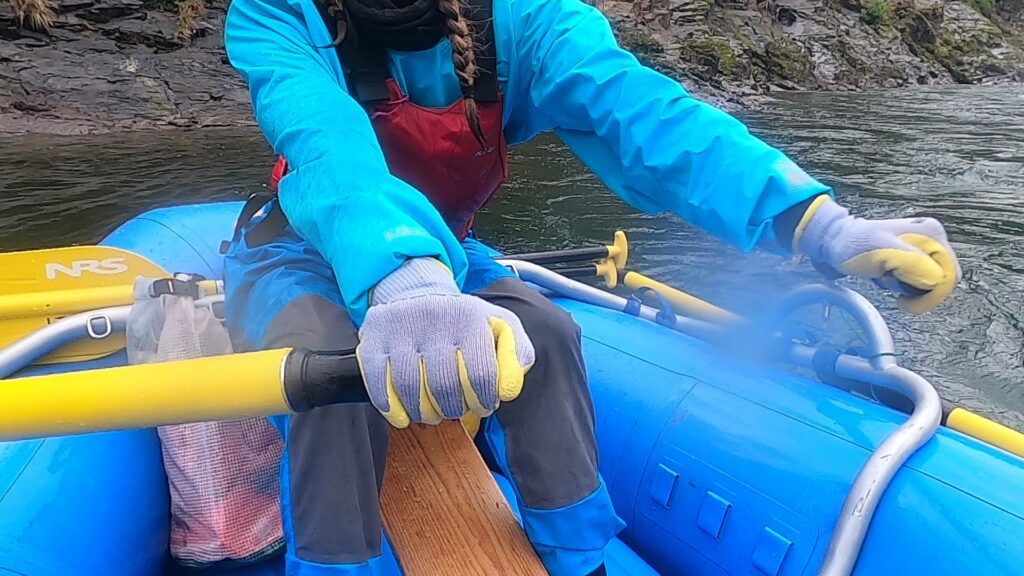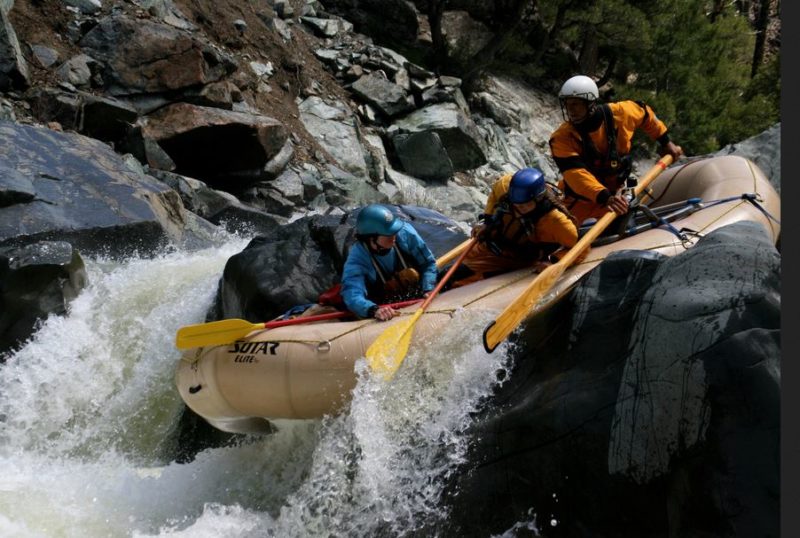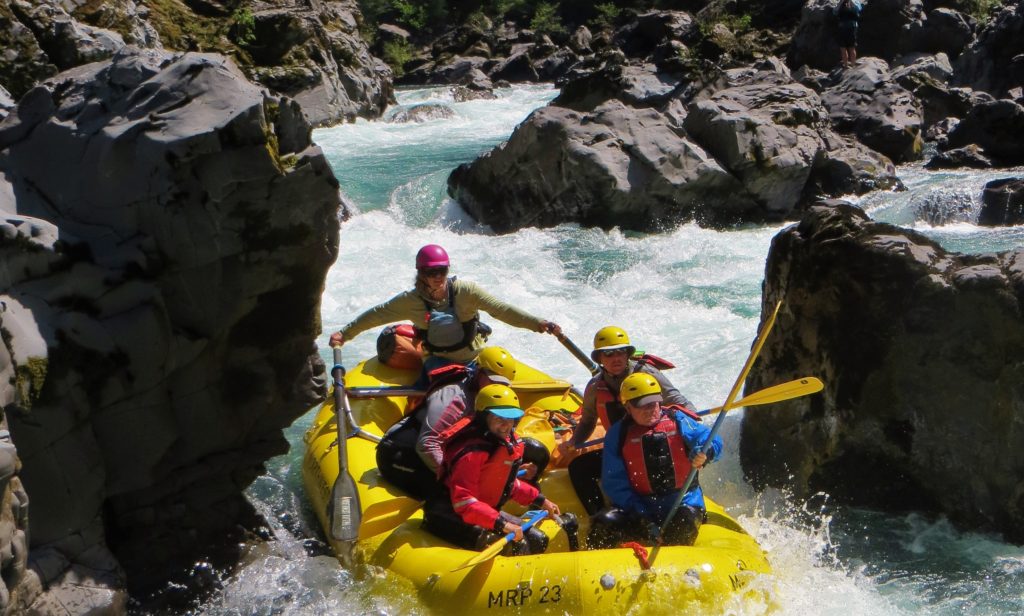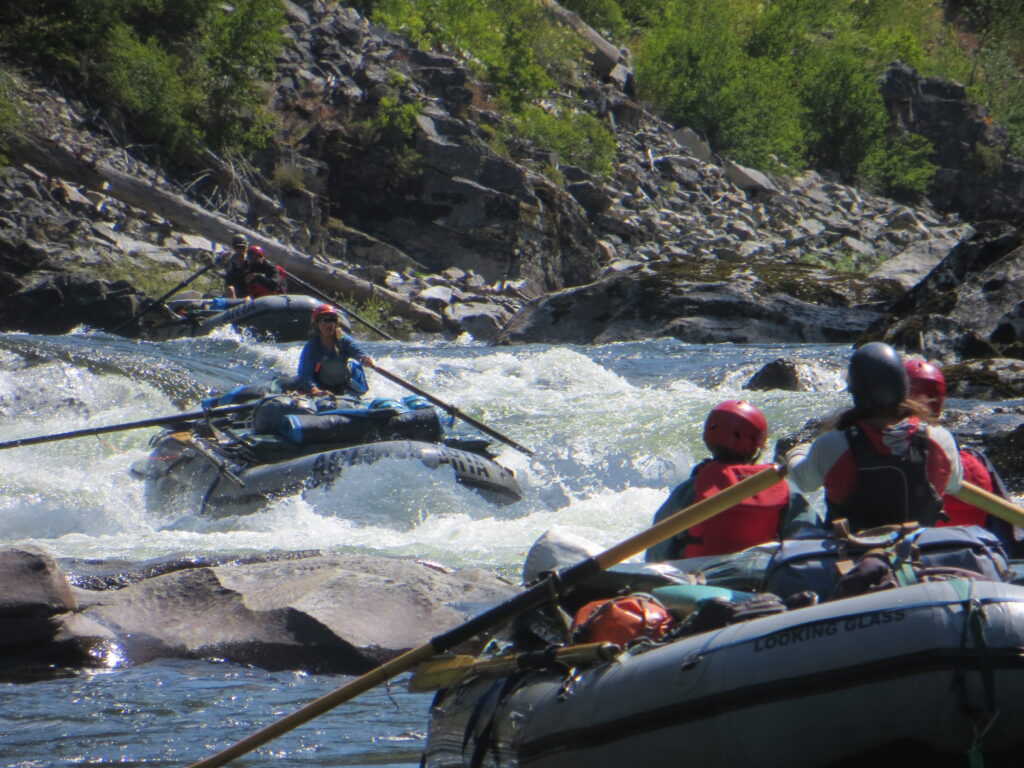Rowing whitewater rafts requires skills and attention to safety. Whether rowing a gear raft, oar/paddle combo or cataraft understanding the right techniques for handling your oars allows you to minimize risk and maximize boat control. This post covers best practices for oar management and rowing techniques.
Basic Safety Rules for Rowing Whitewater Rafts
- Avoid having the oar handles pointed at your body. In general keep the handles in front of you or shipped so that if you catch an oar it will shoot across in front or behind you.
- Watch your downstream oar. A downstream oar tip can easily catch a rock, causing the handle to shoot toward you or the oar to wedge in place. This could result in an injury from the oar, a broken oar or even your raft wrapping around the oar.
- Ship your oars and ride your gear. Avoid trying to take that last stroke instead ship your oar(s) early and allow the raft to bounce of the rock or object. One of the most common causes of river trip injury. I’ve seen multiple fat lips, bleeding foreheads, smashes thumbs and even a permanently numb cheek from not shipping early.
- Hold onto your oars. When a loose oar swings around both the blade and the handle become weapons.
- Practice turning using both oars. Build muscle memory by turning with both oars until it feels automatic. Then, experiment with how using one oar versus two impacts your momentum.
- Every stroke requires micro (sometimes macro) adjustments to keep your raft moving in the desired direction. Be aware that your oars may be in different water, forcing you to adjust the amount of force you are applying to each oar.
Rowing Techniques
Forward/Pushing Strokes with two arms
- Keep your arms straight and pivot at your hips, leaning forward to maximize power.
- During recovery, keep your shoulders in front of your hips to maintain balance and be able to apply the maximum force to the next stroke.
Portaging Strokes/Staggered Rowing
Push with one arm and then the other. This technique helps vary body motion but is less efficient than pushing with both oars simultaneously. Using each oar separately, the raft tends to turn slightly back and forth during each stroke.
Pulling (Backward) Strokes
Start your stroke with your hands and shoulders as far forward as possible. Then put the oar blades in the water and pull backwards. In general avoid having oars point at your body at the end of a stroke by starting your stroke recovery earlier.

Turning and Pivoting
Two-Oar Pivot
- With both oars out of the water, position one oar handle away from your body and the other close to your chest.
- Put both oars into the water simultaneously, then switch their positions as you push and pull at the same time.
- Recover by pulling the oar blades out of the water and returning your handles back to their original positions, and repeat the motion.
- Avoid pointing the oars at your body to minimize injury risk.

One-Oar vs. Two-Oar Turning
After getting comfortable using two oar pivots, start to think about when to use a two oar pivot versus when to use just one oar to turn. For example, when rowing a raft in flatwater pulling backwards with an oar causes the raft to lose momentum.

Shipping Your Oars
Arguably the most critical skill for safe and effective whitewater rowing, proper shipping keeps you from hurting yourself and sets you up to use your oar(s) immediately after passing an obstacle.
How to Ship Oars Properly
- When shipping, bring your oar blade forward by pushing your handle backwards and to the side.
- During this process switch your hand grip so that your thump goes from being closest to the handle end of the oar to your pinky being closest to the handle end.
- Be sure to get your blade high out of the water (at the top of the tube) and tight against the raft so that if you get thrown around a bit your oar blade will not end up in the water.

Less Desirable Shipping Techniques
1. Handles Forward – OK
Less desirable than regular (good) shipping of the handles backwards, in a pinch you can push your handles forward to ship.
Handles forwards makes it hard to hold onto the oars and difficult to keep rowing with one oar when you shipped the other oar. You also must wait longer to use the oar when passing an object.

2. Pushing Handles Down – Bad
Pushing handles down and lifting blades up leads to broken gear and injuries. Too often as the raft goes past the rock trying to be avoided the oar shaft or blade catches the rock forcing the rowers hand down into the raft. If running a slant board this commonly causes thumb injuries. Oars also get broken this way and sometimes it causes the raft to pivot sideways leading to more issues.
3. Pulling Oars In – Bad
Another poor technique, pulling oars in to ship also leads to broken gear and injuries. Commonly, when a rower pulls the oar in the blade stops below the lock. This leaves the blade exposed to catch on an obstacle and bend or snap off. Alternatively, the blade might catch a rock and force the oar shaft to sweep across the raft. This can knock gear and people overboard or pin the rower under the oar.
Both the “handles down” and “pulling oars in” methods increase the risk of injuries and broken oars because rowers frequently underestimate the space needed. Instead, ship your oars early with the blades facing forward. If you find yourself resorting to one of these three less desirable methods, consider acting sooner next time..

Downstream Ferries
While difficult to perform, a downstream ferry (where you pull downstream) requires practice to properly perform when rowing whitewater rafts. Rowers commonly practice by rowing into eddies or pulling out of the current in Class I and II tongues. Necessary for navigating high volume rivers like the Grand Canyon or highwater rafting on many other rivers, rowers must pull downstream through large lateral waves to get out of the main current and avoid large features. It’s also commonly used running class IV and V whitewater by pulling behind rocks to catch eddy water.
Oar Locks and Rights
The two primary ways people run oars when rowing whitewater rafts these days, locks with rights and straight (open) locks each have advantages. While I still like pins and clips, pretty much no one sells them anymore. Unfortunately, many people thinks rights are just for learning. Both options have advantages and are used by expert rowers.

Locks with Rights
Locks with rights refer to a specific attachment (a right) on the oar that helps prevent the oar from spinning while being rowed.
Advantages of Using Rights:
- Less Likely to Miss a Stroke: With rights, the oar stays aligned and more easily engages the water for each stroke. This reduces the chance of missing strokes, especially during dynamic river conditions where quick and consistent strokes are needed.
- Prevents Oar Damage: Rights also protect your oars from damage. Without them, oars can spin sideways in the water and then pulled under the raft, which can result in the oar shaft snapping. The right keeps the oar blade perpendicular to the surface of the water such that the river forces the oar forward or back along the surface of the river rather than under the raft.
- Quick Transition from Shipping to rowing: When shipping your oars, the rights allow you to immediately take a stroke after recovering the oar. This is particularly useful in situations where you need to make a quick move after a drop and pinch point. It eliminates the need to rotate oar before the next stroke.
Hard Rivers where Guides Prefer Rights: The Futaleufú River with frequent shipping and the need for rapid changes in direction many guides used oars with rights consistently. The rights also minimized the risk of the oars being spun sideways or caught under the raft, which leads to broken oars. We had a rule that new guides to our company (usually well seasoned) must demonstrate proficiency before using open locks. This policy helped ensure that we had oars for the season.
In addition, many top catarafters use rights along with bungees. The bungess help secure their oars in the locks. One reason clips were popular is that they prevented the oar from sliding in and out. This gave the rower extra stability that open locks or locks with rights didn’t provide. The bungees serve a similar purpose, offering that additional stabilization.

Straight (Open) Oar Locks
Often favored by more experienced rowers or for specific conditions, straight or open oar locks do not have rights attached. These locks allow for more freedom to spin the oars, providing a smoother recovery and more flexibility during strokes.
Advantages of Straight Locks:
- Smoother Recovery: With no rights to restrict the oar’s movement, rowers can recover the oar more smoothly, particularly in flatwater, through big uneven waves or when navigating shallow areas. The absence of rights also allows the oar to drag along the surface of the water, facilitating smoother transitions between strokes.
- Better Maneuverability in Shallow Water: In shallow conditions, the lack of rights allows the oar to move more easily along the surface, making it easier to avoid obstacles and adapt to the terrain.
- Beneficial in windy conditions: Open oar locks reduce drag during the recovery phase. Without the rights restricting movement, the oar can be tilted to slice through the wind, whereas oar locks with rights keep the blades in position that maximizes drag during the recovery.
Challenges with Straight Locks:
- Without rights, the oars spin fairly often while in the water, especially during rough conditions. This increases the chance of the oar being pulled under the raft, leading to potential damage or difficulty in completing strokes.
When to Use Rights vs. Straight Locks
Many rafters start rowing oars with rights to learn proper technique and prevent damage to the oars. As their skills improve, they switch to straight locks for more maneuverability and smoother stroke recovery. However, for whitewater conditions where quick, responsive strokes are critical, rights are still a good choice.
Some rowers prefer using rights when their wrists are sore since they don’t need to use as much force to keep the oar from rotating. While rowers with a sore back find open locks allows them to put less strain on their backs. In addition, if you have warped oars, rights or pins and clips make the oars much easier to use.

Concluding Thoughts on Rowing Whitewater Rafts
Don’t get hurt or hurt anyone else with your oars. Learn to properly ship your oars and use your oars in such a way that they aren’t pointing at your body. All the of rowing techniques will come with repetition. That said, learn two-oar pivots and how to downstream ferry. Happy rowing!


